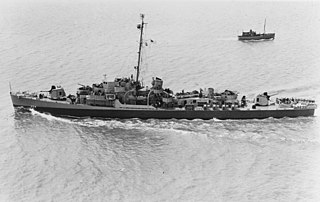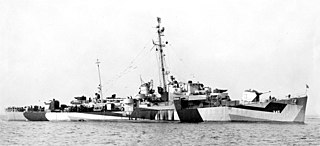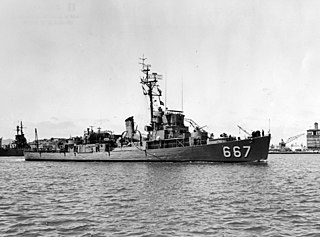
USS Herbert (DD-160) was a Wickes-class destroyer. She was named for Hilary A. Herbert (1834–1919), Secretary of the Navy from 1893 to 1897.

USS Abercrombie (DE-343) was a John C. Butler-class destroyer escort in the service of the United States Navy from 1944 to 1946. She was finally sunk as a target in 1968.

USS John C. Butler (DE-339) was the lead ship of her class of destroyer escorts in the service with the United States Navy from 1944 to 1946. She was recommissioned between 1950 and 1957 and finally sunk as a target in 1971.

USS Rudderow (DE-224) was the lead ship of her class of destroyer escorts, in service with the United States Navy from 1944 to 1947. After spending decades in reserve, she was sold for scrap in 1970.

USS Weeden (DE-797) was a Buckley-class destroyer escort in service with the United States Navy from 1944 to 1946 and from 1950 to 1958. She was scrapped in 1969.

USS Major (DE-796) was a Buckley-class destroyer escort in service with the United States Navy from 1944 to 1948. She was scrapped in 1973.

USS Robert Brazier (DE-345) was a John C. Butler-class destroyer escort in service with the United States Navy from 1944 to 1946. She was sunk as a target in 1969.

USS Gentry (DE-349) was a John C. Butler-class destroyer escort acquired by the U.S. Navy during World War II. The primary purpose of the destroyer escort was to escort and protect ships in convoy, in addition to other tasks as assigned, such as patrol or radar picket.

USS Jaccard (DE-355) was a John C. Butler-class destroyer escort acquired by the U.S. Navy during World War II. The primary purpose of the destroyer escort was to escort and protect ships in convoy, in addition to other tasks as assigned, such as patrol or radar picket. Post-war, she returned home with one battle star to her credit.

USS Woodson (DE-359) was a John C. Butler-class destroyer escort acquired by the United States Navy during World War II. The primary purpose of the destroyer escort was to escort and protect ships in convoy, in addition to other tasks as assigned, such as patrol or radar picket.
USS Johnnie Hutchins (DE-360) was a John C. Butler-class destroyer escort acquired by the U.S. Navy during World War II. The primary purpose of the destroyer escort was to escort and protect ships in convoy, in addition to other tasks as assigned, such as patrol or radar picket. She served in the Pacific Ocean, and, post-war, she returned home with a Navy Unit Commendation awarded to her for her battle with Japanese midget submarines on 9 August 1945.

USS Rombach (DE-364) was a John C. Butler-class destroyer escort acquired by the U.S. Navy during World War II. The primary purpose of the destroyer escort was to escort and protect ships in convoy, in addition to other tasks as assigned, such as patrol or radar picket.

USS Oswald A. Powers (DE-542) was a United States Navy John C. Butler-class destroyer escort launched during World War II but never completed.

USS Henry R. Kenyon (DE-683) was a Buckley-class destroyer escort in service with the United States Navy from 1943 to 1947. She was sold for scrap in 1970.

USS Runels (DE-793/APD-85) was a Buckley-class destroyer escort of the United States Navy, in service from 1944 to 1947. She was finally sold for scrap in 1961.

USS Wiseman (DE-667) was a Buckley-class destroyer escort in service with the United States Navy for several periods between 1944 and 1973. She was scrapped in 1974.

USS Riley (DE-579) was a Rudderow-class destroyer escort in the United States Navy during World War II. She later transferred to the Republic of China Navy and served as Tai Yuan (DE-27). The ship was finally scrapped in 1996.

USS Peiffer (DE-588) was a Rudderow-class destroyer escort in service with the United States Navy from 1944 to 1946. She was sold for scrapping in 1967.

USS John Q. Roberts (APD-94), ex-DE-235, was a United States Navy high-speed transport in commission from 1945 to 1946.

USS Bassett (APD-73), ex-DE-672, was a United States Navy high-speed transport in commission from 1945 to 1946 and from 1950 to 1957.



















